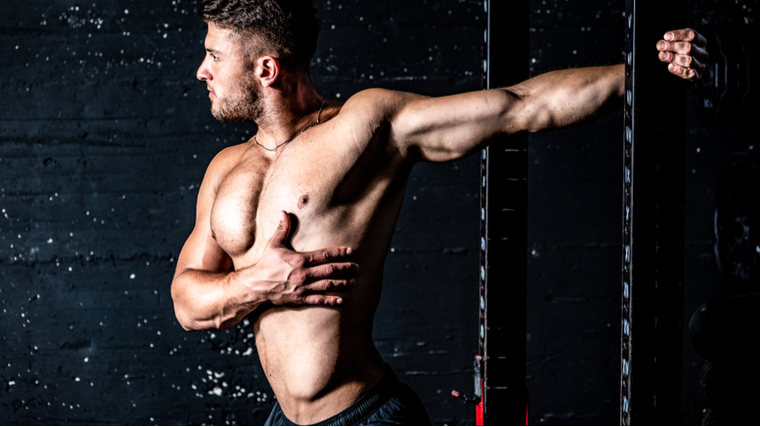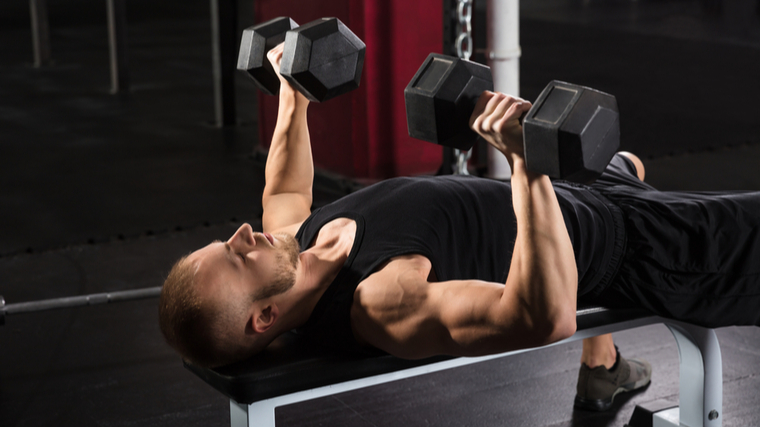The Best Dumbbell Chest Workouts for Beginners, Strength, and More | BarBend (original) (raw)
Gym rats the world over are constantly on the hunt for the best ways to build an impressive set of pecs. Dumbbell exercises are a staple for many muscle groups — and luckily, the chest is no different. Since they offer a ton of utility, dumbbells can serve effectively as main training implements or as complements to barbells, machines, cables, or calisthenics.
Whether at the gym or at home, or training for strength or hypertrophy, here are five fantastic dumbbell chest workouts for you to dive into.
Best Dumbbell Chest Workouts
- **Best Dumbbell Chest Workout for Beginners
- Best Dumbbell Chest Workout for More Muscle
- Best Dumbbell Chest Workout for Strength
- Best Dumbbell Chest Workout for Stability
- Best Limited Weight Dumbbell Chest Workout
Beginners benefit greatly from setting boundaries to range of motion as they get the hang of controlling independent training implements like dumbbells. While a good set of dumbbells can provide utility and variability, first you need to establish a solid foundation of shoulder stability.
The Workout
Using “floor” variations of dumbbell exercises will introduce control and positional awareness that can be progressed as the trainee develops. Floor presses and flyes are fantastic options here, since they’re straightforward and don’t have complex technique demands.
- Dumbbell Floor Press: 3 x 10 – 15
- Dumbbell Floor Flye: 3 x 10 – 15
- Single-arm Dumbbell Floor Press: 3 x 10 – 15
Note: The notation in all workouts is defined as (sets) x (reps).
Coach’s Tip_:_ Some beginners may find that they can’t feel their chest working during pressing movements. Be patient with your training and let your body find its natural rhythm.
Best Dumbbell Chest Workout for More Muscle
Hypertrophy training is all about building muscle, and to do that, you need the chest to get as close to technical fatigue as possible. Building a strong pec shelf requires patience, dedication, and precise performance with your implement of choice.
The best way to take advantage of the dumbbells is by hitting the chest from multiple angles with pressing and flye variations.
The Workout
To make progress with your chest training, you can manipulate your approach to technical fatigue by adding weight, tempo, repetitions, or reducing rest periods. Ensure you’re progressing each workout by either adding more weight, reps, lifting with a slower tempo, or cutting down your rest time. There are myriad ways to manipulate training variables for optimal chest growth.
- Dumbbell Bench Press: 3 x 8 – 12
- Incline Dumbbell Bench Press: 3 x 10 – 12
- Dumbbell Pec Flye: 3 x 10 – 12
Coach’s Tip_:_ Take your time on each repetition to find the “groove” and maintain a solid mind-muscle connection.
Best Dumbbell Chest Workout for Strength
Most people think of the barbell as the weapon of choice for raw strength and power. While true, it doesn’t mean that dumbbells don’t deserve a seat at the table too.

Credit: Jasminko Ibrakovic / Shutterstock
Training for strength goes hand-in-hand with maintaining mobility and stability of the shoulder. To get strong you’ll have to lift heavier, but to stay safe while doing so you’ll need to keep a few exercises in the program to manage joint health.
The Workout
The workout should begin with a dumbbell pullover to help mobilize the upper body and be followed by an exercise to help cue stability of your pressing muscles. From there, prioritize heavy pressing as well as lighter incline work to continue advancing your stability as you get stronger.
Preparatory Drills
- Dumbbell Pullover: 2 x 10 – 12
- Bottoms-Up Kettlebell Press: 2 x 10 – 12 rper arm
- Single-arm Dumbbell Bench Press: 2 x 10 – 12 per arm
Main Workout
- Dumbbell Bench Press: 3 x 6 – 8
- Incline Dumbbell Bench Press: 3 x 8 – 10
- Incline Dumbbell Pec Flye: 3 x 10 – 12
Coach’s Tip_:_ When it comes to strength development, force output is key. Make sure you’re performing each repetition forcefully and with intent.
Best Dumbbell Chest Workout for Stability
By altering your hand placement and elbow angle, you can put greater emphasis on your stabilizers and help build up strong, sturdy shoulders. Unilateral work can also force heightened awareness of the core and leg musculature that carries over to bilateral dumbbell and barbell work in the future.
The Workout
Neutral-grip, incline, and unilateral dumbbell pressing or flye variations will all stress your skill and stability by taking us out of the direct line of pull of gravity. With greater demand on stability, you should aim to perform higher repetitions with moderate weight.
- Neutral-grip Dumbbell Bench Press: 3 x 10 – 12
- Incline Neutral-grip Dumbbell Bench Press: 3 x 12 – 15
- Incline Dumbbell Pec Flye: 3 x 10 – 12
- Single-arm Incline Dumbbell Bench Press: 3 x 10 – 12
Coach’s Tip_:_ to nail down stability from start to finish, feel free to pause at any point in the range of motion that doesn’t feel locked-in or stable.
Best Limited Weight Dumbbell Chest Workout
If you can’t make it to your gym and don’t have the home gym you’ve always wanted, don’t worry. Even though access to machines and cables galore is a luxury, there are still ways to shred your pecs without relying on a cable tree or Smith machine. With a bit of ingenuity and willingness to feel the burn, at-home chest training can still be effective — all you need is a pair of dumbbells.
The Workout
In order to optimize efficacy with limited weight, look to pre-exhaust the chest with calisthenics. Push-ups are a fantastic way to fatigue the chest before turning to dumbbells, making what may be an easy workout much harder.
You can also reverse-engineer the workout and place flye exercises before pressing to make limited weight feel that much heavier.
- Push-Ups: 3 x AMRAP
- Dumbbell Floor Flye: 3 x 12 – 15
- Single-arm Dumbbell Floor Flye: 3 x 10 – 12
- Dumbbell Floor Press: 3 x 10 – 12
Coach’s Tip_:_ Anchor your free hand on a doorway to perform the single-arm dumbbell floor flye.
Anatomy of the Chest
The chest is comprised of two major compartments that attach from the sternum (ribcage) to the clavicle (collarbone) and humerus (upper arm). Despite the lingering myth that it is possible to isolate the “inner” or “lower” chest for development, understanding the anatomical structure and function of the pecs is important for guiding your approach to chest training.
Pectoralis Major
The pectoralis major is the largest and most prominent of the chest muscles. It originates all along the collarbone and sternum and inserts onto the humerus, the bone of the upper arm. Its main function is to pull the arm in front of or across the body.

Credit: Srdjan Randjelovic / Shutterstock
Depending on the angle of the movement, you can alter which part of the chest gets a little bit more emphasis.
Pectoralis Minor
The pectoralis minor is a smaller chest muscle that can be found underneath the pectoralis major. It attaches to the ribs and scapula, meaning that exercises that require scapular stability or protraction (reaching) will both target the pectoralis minor, but it still plays a supporting role in most standard pressing movements.
[RELATED: Best Lower Chest Exercises]
Serratus Anterior
Although the serratus anterior may not technically be a chest muscle, a well-developed serratus does help round out a solid chest aesthetic. The serratus anterior helps stabilize and manipulate the shoulder blade while visually producing the finger-like muscles along the upper sides of the core. Similarly to the pectoralis minor, you can target the serratus anterior by performing exercises that involve protraction of the scapula.
Benefits of Dumbbell Chest Training
A well-developed chest is often the centerpiece of a good physique, but aesthetics don’t have to be the only motivating factor. Consistent dumbbell chest training can provide benefits to overall upper body muscle balance, added growth stimulus to stubborn muscles of the arms, and improve stability.
Upper Body Balance
Dumbbell chest training encourages both sides of the chest to develop evenly, while training strictly with machines or barbells can allow for compensations. The independent load being held in each hand forces the strength and coordination of each side to even out, which should serve as a form of injury risk management and helps stave off plateaus.
Arm Training
Anytime you dumbbell chest press, your shoulders and triceps are also involved. Adding in additional pressing stimulus can also help with triceps growth and development – thereby making any triceps work done later in isolation that much more effective.
Improved Stability
Training with dumbbells requires a level of stability that machines typically don’t provide. What’s more, training with barbells when shoulder stability is lacking is a recipe for disaster. Adding in dumbbell exercises can facilitate improved shoulder stability through independent loading of each arm.
How to Program Dumbbell Chest Workouts
Developing the chest often requires a combination of various barbell, machine, cable, and dumbbell exercises. You can program dumbbell chest workouts through independent training blocks that focus exclusively on dumbbell exercises for several weeks, or, be woven into multi-implement training styles.
When programming complete training blocks centered around dumbbell training, it’s important to include multiple exercises at different incline positions (either flat, low, middle, or high incline) to bias specific areas of the chest and reinforce stability.

Credit: Andrey_Popov / Shutterstock
**_[Read More: The_** Best Upper Body Exercises and Workouts]
When woven into a larger, more comprehensive training block, dumbbells can often serve as the proverbial glue that holds everything together. Use dumbbells to your advantage, filling in the gaps that machines or barbells may not be able to cover.
For example, dumbbells often provide greater range of motion and variability than their machine or barbell counterparts. The ability to customize dumbbell technique to your body type allows for each exercise to be taken to the fullest range of motion possible, providing excellent muscle growth stimulus while also staving off sticking points or joint stability issues.
How to Warm Up for Dumbbell Workouts
Warming up the shoulders, pecs, and back is an excellent way to improve dumbbell chest workouts. Mobilizing the shoulders with band pull-aparts or shoulder rotations, lightly stretching the pecs and lats for improved pressing range of motion, and prepping the back for improved bracing technique will all pay dividends for force output and safety.
Exercises such as bottoms-up kettlebell pressing or single arm dumbbell exercises are a great way to cue stability of the shoulders to keep us safe. Cueing stability before your main exercises helps to ensure that the dumbbells don’t drift away or cause injury.
Wrapping Up
Dumbbells serve as the perfect complement to almost any form of chest training, but can also be the main course of your bodybuilding meal.
Whether you want to develop your physique, build strength, or modify your stability, dumbbells are one of the few implements that can be considered a one-stop-shop. From the floor to the bench, on an incline or flat, press or flye, dumbbell work offers unparalleled variability and customization to your chest training.
Featured Image: Andrey_Popov / Shutterstock